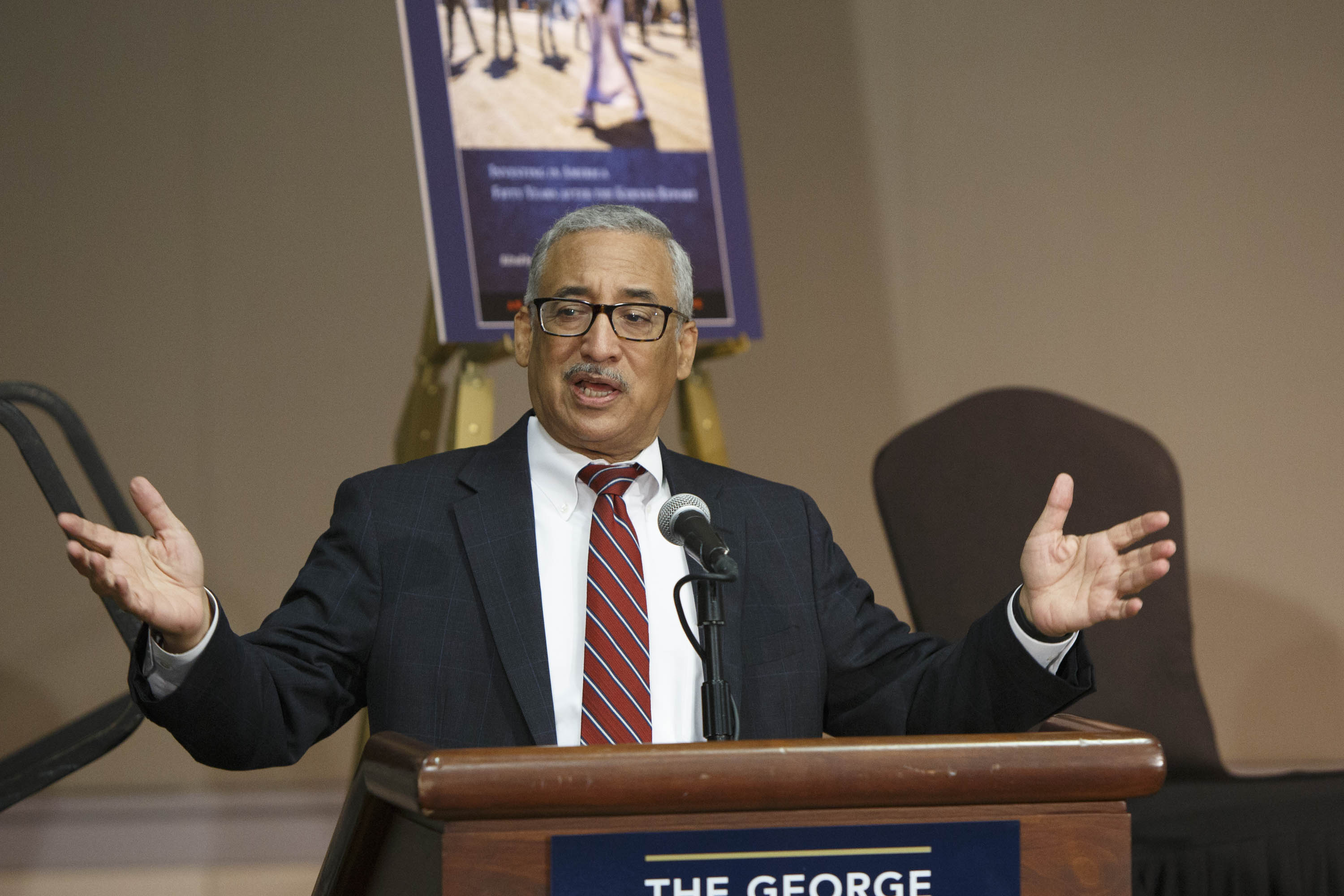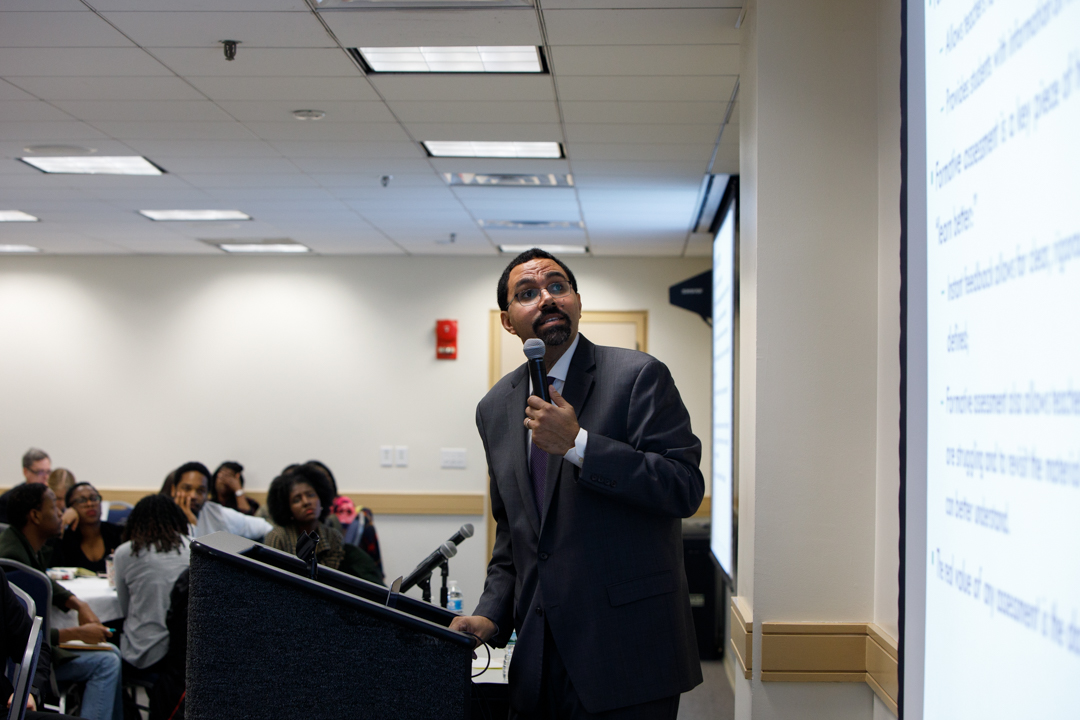By Ruth Steinhardt
“Our nation is moving toward two societies, one black, one white, separate and unequal,” the National Advisory Commission on Civil Disorders, known as the Kerner Commission, wrote in 1968 after racial tensions boiled over into riots in Chicago, Detroit, Los Angeles and elsewhere.
Fifty years later, the inequities that led to that unrest have not been solved and in many ways have worsened, speakers said Thursday at the George Washington University. The daylong symposium, “Healing Our Divided Society: National Kerner Fiftieth Report Card Forum,” was cohosted by the Graduate School of Education and Human Development and was the first of two release events for the Eisenhower Foundation’s book-length report of the same name.
“The more things change, the more they stay the same,” said Rep. Bobby Scott (D-Va.), the first African-American elected to Congress from Virginia since Reconstruction. “Our nation’s schools are resegregating by race and class, and getting worse—not better—at an alarming rate.”
The Kerner Commission was a damning indictment of the conditions under which African-American populations lived, writing in its 1968 report that “White racism is essentially responsible for the explosive mixture which has been accumulating in our cities since the end of World War II.” Systemic discrimination in education, housing and employment, the commission wrote, had resulted in the exclusion of these populations from the benefits of postwar economic progress.
The Kerner Commission report even bemoaned official responses to the riots, writing that “little basic change in the conditions underlying the outbreak of disorder has taken place” and that “in several cities, the principal official response has been to train and equip the police with more sophisticated weapons.”
As several speakers pointed out, its language echoes that of today’s civil rights activists after uprisings in Ferguson, Mo., Baltimore and other major cities.
“It’s kind of like Alice in Wonderland. The same pictures shown over and over again, the same analysis, the same recommendations and the same inaction,” Mr. Scott said.
The symposium brought together lawmakers, activists, educators and more, including Mr. Scott, U.S. Commission on Civil Rights Chair Catherine Lhamon and former Sen. Fred Harris (D-Okla.), the last living member of the commission, who originally pitched the idea of it to then-President Lyndon B. Johnson.
Mr. Harris, around whose book the forum was structured, said that in the years after the report was released, many of its recommendations were adopted and Americans made significant headway on issues of racial disparity. But then the federal and state social programs that had helped were recast as “entitlements” and began to receive less attention and funding.
“We made progress on virtually every aspect of race and poverty for nearly a decade,” Mr. Harris said. “Then that progress slowed, stopped and in many ways was reversed.”
Racial segregation in schools and neighborhoods persists, according to the new report. In 1988, 44 percent of black students attended majority white schools, but by 2016 that percentage had fallen to 20 percent. The majority of black and Hispanic students attend schools with a poverty rate of more than 75 percent. The child poverty rate was 15.6 when the Kerner report was released, but in 2017 it was 21 percent, with black and Latino children particularly at risk.
And the poor are poorer. In 1975, 30 percent of poor Americans lived in “deep poverty,” at less than half of the federal poverty level. By 2016, that increased to 46 percent.
There was some good news, speakers said. For instance, dropout rates are at a historic low, and the greatest progress has been made among students of color.
“We need to be ready to say that the progress we’ve made was insufficient, but we’re holding it, and we’re going to do substantially more,” Ms. Lhamon said. Unlike her mother, Ms. Lhamon said, she was not forced to drink from segregated water fountains or to ride in the back of city buses. But her own school-age daughters still needed reassurance and messages of inclusion after Donald Trump’s election in 2016.
The most rousing speaker of the day may have been fifth grader Tchanori Kore, a winner of the Gardere Martin Luther King Jr. Oratory Competition, who got a standing ovation from the hundreds of attendees.
“Dr. King said ‘I have a dream that little black boys and black girls will be able to join hands with little white boys and white girls as sisters and brothers,’” Tchanori said. “Well, I believe only if these children who are joining hands are not hungry, have had a good night’s sleep and a decent home and have received the best education and the best healthcare. Then we will be able to say that Martin Luther King’s dream has really come true.”
Mr. Harris said that while he was disappointed by backsliding and inaction on issues of racial equality, he was “heartened” by many aspects of 2018’s civil rights landscape.
“If you look back to the beginning days of [the modern] civil rights movement, things were far tougher then than they are now,” he said. “Jim Crow was the law, not just practice…but still [activists] resisted, persisted and ultimately prevailed. Furthermore, public opinion is on our side…there’s more activism in this country right now than I’ve seen in my lifetime. People want to do something and they are doing something.”
Ms. Lhamon said activists could not afford to be discouraged by living in “dangerous and worrisome times.”
“Losing hope is not a viable option,” she said. “What that truism means is equity is not a destination to be reached. Living in equity…means nurturing that equity. We do not get to walk away.”



